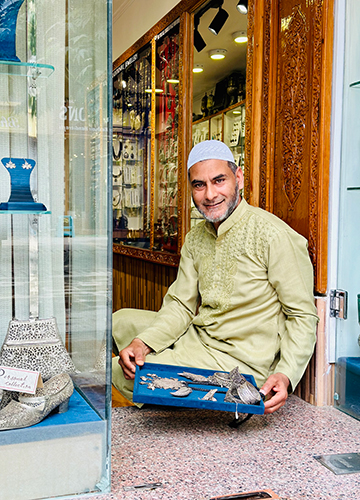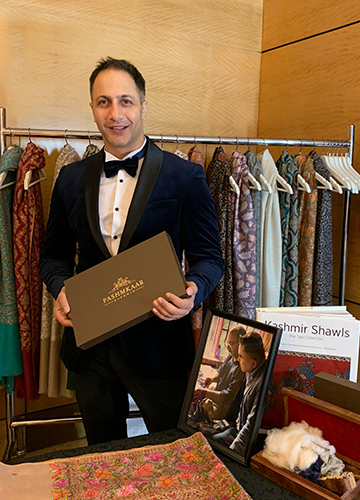There is always so much talk in fashion about the great strides Indian designers have made―both in India as well as internationally. Stalwarts such as Tarun Tahiliani have launched highly profitable joint ventures with Indian corporates, masters like Sabyasachi are reaching a milestone after another financially, and young guns such as Dhruv Kapoor and Rahul Mishra have taken over Milan Fashion Week and Paris Fashion Week by storm.
It makes one wonder about how much talent must the rest of the country, those outside our megapolises or even in more far-flung politically troubled areas, possess. Like Kashmir, the land of immense beauty that has inspired everyone, from ancient Greeks to Sufi saints to even Bollywood.

“Kashmir is called the Valley of the Sufis. We are highly spiritual people,” says Tariq Dar, “Craft for us is akin to spirituality.” Dar, 46, and his label Pashmkaar, is one of the valley’s upcoming fashion labels that aims at selling across India and internationally as well. “I come from an artisan family. My father was 12 years old when his father died, and he was forced to be the breadwinner. His first salary for making an embroidered shawl was 25 paise,” Dar recounts. “But before getting married, he decided he would sell his shawls himself, instead of working for others. He started a small unit of his own. I was thus born into colour and embroidery, into craft and culture.”
Dar founded his label in 2011, taking the name from its Persian origins (‘Pashm’ means the finest silk in Persian, and ‘kaar’ means ‘work’). Pashmkaar makes the finest embroidered shawls out of Kashmir, but also saris in pashmina, pherans (the traditional tunics of the state) in velvet, silk and wool that Dar says even clients in New York are crazy about, and jackets in aari work. “Our aari, sozni and tilla work are the finest. We are expensive, but the masters of the craft,” he reasons.

What is it like living and working out of Kashmir? “Operationally it is very difficult,” says Aadil Masood, 35, who launched his label Cilwana in 2018. “It is very tough to run a successful business here. Political issues have slowed us down. Our work culture is also not as efficient as New Delhi’s,” he explains. What Aadil and his designer wife Nusaiba, 33, decided to do was keep the craft as local as possible instead. “We have kaarkhanas (workshops) in many Indian cities,” he says, “For example, we do our chikankari in Lucknow, our embroidery in Bareilly, and our jootis (Indian mules) come from Punjab. This way we use the best artisans from across India. We used to have a factory here that employed 80-100 people, but this is a better model as it respects the workmanship of local artisans. There are no shortcuts.”
Masood and his wife had a corporate existence in Dubai―he worked for Nestle and she for Citibank―before they moved back to Srinagar. “My father was being treated in a New Delhi hospital and we had moved there temporarily. Nusaiba did a fashion designing course at the Pearl Academy. We launched an online brand and were sold out immediately,” he recalls. Masood says his model of sourcing locally instead of buying from wholesale has held him in good stead.
Tul Palav is one the most beautiful bridal labels in India, and yet one that is relatively unknown to much of the country. It was founded by Iqra Malik, 32, nine years ago, a long-cherished dream of being in fashion as a young child. “There were no fashion schools in Kashmir at all, maybe a couple of courses, but nothing that gave you a degree,” she says, “I had to pursue the arts stream. But after my master’s, I was interning at Red Cross when I realised I couldn’t stay away from design any longer. I didn’t know much, but I came up with the name ‘Tul Palav’. It’s a very common Kashmiri proverb “Tul Palav, Vat Salav”, which means pick up your clothes and get going.
The Kashmiri populace connected with the name immediately. Moreover, Iqra was known as always being well-dressed among her friends. “I launched Tul Palav on Instagram with just 20 items. Within 30 minutes all of them were sold out,” she adds.
Iqra married Rameez Malik, a software engineer from Chicago and moved to the US. “But I couldn’t run my label long-distance. Eventually both of us moved back. He now works with Tul Palav, he handles marketing and the business end of the label. This was, of course, so controversial in Kashmir,” she laughs.
Tul Palav is a “proudly Kashmiri brand”, Iqra says. “Our embroidery is purely Kashmiri. We will bring in elements of Afghan or Lucknowi work, but the soul of Kashmir is evident in everything we do.” Tul Palav’s pherans are highly regarded bridal pieces for Kashmiri women, as every local bride has a pheran in her trousseau. Soni Razdan and Kiran Rao have also shopped at her Srinagar store.
Who knew Kashmiri jewellery used to be a highly coveted item? “All this political upheaval has really taken a toll on Kashmiri arts. Some have survived, like shawls, papier mache and walnut wood. But jewellery has not, we just could not compete with Jaipur,” says Nane Mohammed Mubashir Kathwari, 51, of Corals Gems and Jewels.
Kathwari specialises in Kashmiri hand-crafted silver jewellery and gemstones, with one of his two Srinagar stores in an ancient 150-year-old house, Bait ul Meeras. The Kashmiri chinar, or maple leaf, is a recurring motif in his jewellery as well as cases for combs, watches, spectacles, trinkets and the like. Corals mostly sells contemporary jewellery as Kathwari says, “Limited people like traditional jewellery. Only tourists like traditional jewellery.”
The beautiful Shazia Bashir, 42, moved to Srinagar from New Delhi just a few years back and is blown away by the fabric, colours and crafts of Kashmiri fashion. “Everything is fully handcrafted. But there’s also a mysticism to their work. The shawl makers and embroiderers sing hymns and chat while they work, so a pheran is not just a pheran, it’s a prayer,” she says. Bashir now hosts pop-ups in Srinagar and in New Delhi allowing for a design exchange.
Kashmiri labels are finding ways to reach the world. Tul Palav has 96,000 followers on Instagram, and has begun to participate in exhibitions in New Delhi and Dubai. They are opening a men’s store next month and expanding their bridal store, too. Pashmkaar has 78,000 followers on Instagram, but Dar takes his shawls everywhere from the US to the UK (he has returned from a pop-up at London’s chic Browns hotel). Cilwana has three stores in Srinagar―including one at the airport―and are soon launching their own store in Dubai. They have participated in over 30 exhibitions. Corals works via word of mouth, as Mubashirbhai says he is a one-man show. But Rekha Bharadwaj is a fan as is Kiran Rao. He loaned some jewellery for Bharadwaj’s filmmaker husband Vishal Bharadwaj’s Haider, shot here, a few years ago. He has also showcased at handloom legend Laila Tyabji’s Dastkaar in New Delhi, and with Radhi Parekh, at Artisan’s Centre in Mumabi’s Kala Ghoda.
Kashmiris are the soul of each label here. “Everyone all over has heard of pashmina, but until I had shown them the real deal, they had no idea how extraordinary it actually was. So many brands sold shawls as pashmina, but they were cheap imitations. I wanted to give the world a genuine pashmina brand that would be recognisable internationally. I want to preserve Kashmiri craft and bring dignity to the craftsman. There are 12 steps to making a pashmina, so one shawl gives employment to 12 people,” Dar says.
Iqra agrees. “Things were different for women in fashion, families would not allow them to get into designing thinking the girls would become runway models, as if that was a bad thing,” she laughs. “Earlier we had few Kashmiri women working for us, now there are more. Women have been stitching for years. It is time they take ownership of their skills and become entrepreneurs.”



